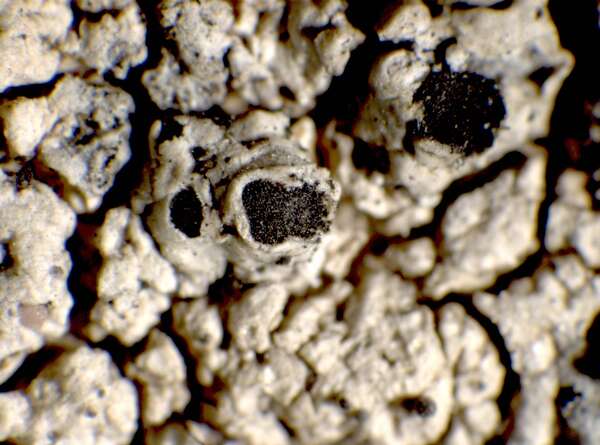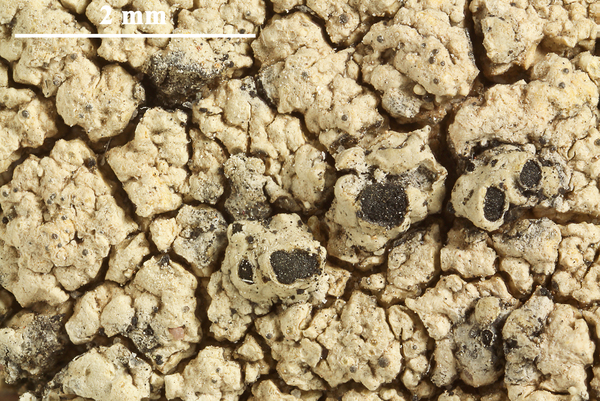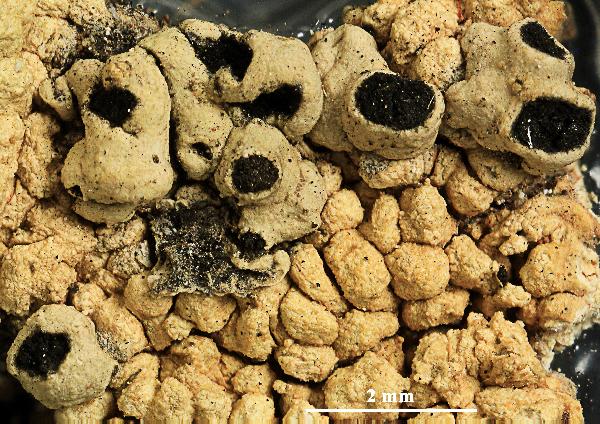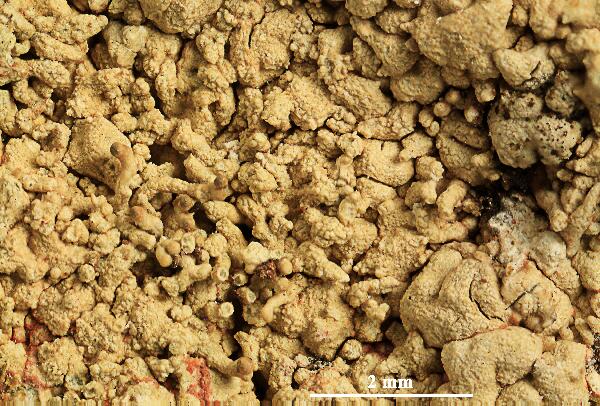Acolium marcianum (B. de Lesd.) M. Prieto & Wedin
Fungal Divers., 2016 (MB 817533). Basionym: Cyphelium marcianum B. de Lesd. - Bull. Soc. Bot. France, 55: 420, 1908.
Synonyms:
Distribution: N - Emil (Nascimbene & al. 2021), Lig (Puntillo & Puntillo 2009, Brackel 2016). C - Tosc (Loppi & al. 1997c, Tretiach & al. 2008, Puntillo & Puntillo 2009, Brackel 2016), Sar (Puntillo & Puntillo 2009, Brackel 2016).
Description: Thallus crustose, lead-grey, pillow-like or poorly evident, infecting the thalli of silicicolous Pertusaria-species. Cortex colourless, 22–80 μm thick, inspersed with crystals; medulla dark in lower part. Apothecia immersed in thalline warts, 0.5-0.8 mm across, usually epruinose, with a black mazaedium. Exciple 36–64 μm thick laterally, dark brown, of strongly sclerotized, interwoven hyphae, with an outer gelatinous layer, strongly thickened (140–160 μm) at base; hypothecium dark brown, of periclinally arranged, sclerotized hyphae. Asci narrowly clavate, formed singly from hooked ascogenous hyphae, persisting until the spores are nearly ripe, with biseriately arranged spores, 28-42 x 3-5 μm. Ascospores 1-septate and constricted at septum, brown, broadly ellipsoid, (10-)11-15(-18) x (6-)7-10(-12) µm, with an ornamentation of a few, spirally arranged, shallow wall fissures. Photobiont chlorococcoid. Spot tests: K-, C-, KC-, P-. Chemistry: without lichen substances.Note: a rare lichen growing on silicicolous pertusarioid species, especially Ochrolechia microstictoides. Mostly Tyrrhenian in Italy.
Growth form: Crustose
Substrata: rocks
Photobiont: green algae other than Trentepohlia
Reproductive strategy: mainly sexual
Most common in areas with a humid-warm climate (e.g. most of Tyrrenian Italy)
paras Pertusaria spp.
Commonnes-rarity: (info)
Alpine belt: absent
Subalpine belt: absent
Oromediterranean belt: absent
Montane belt: very rare
Submediterranean belt: absent
Padanian area: absent
Humid submediterranean belt: very rare
Humid mediterranean belt: extremely rare
Dry mediterranean belt: absent

Predictive model
Herbarium samples
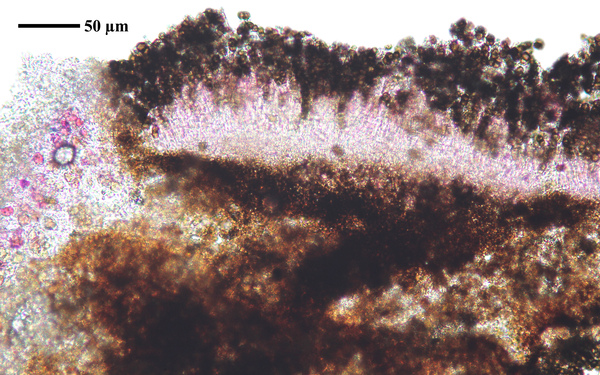

Felix Schumm - CC BY-SA 4.0
[TSB_16773], Spain, Castellò, Pina de Montalgrao, Santa Barbara, on quartzitic sandstone, c. 1300 m. Leg. V. Calatayud, 21.03.1992
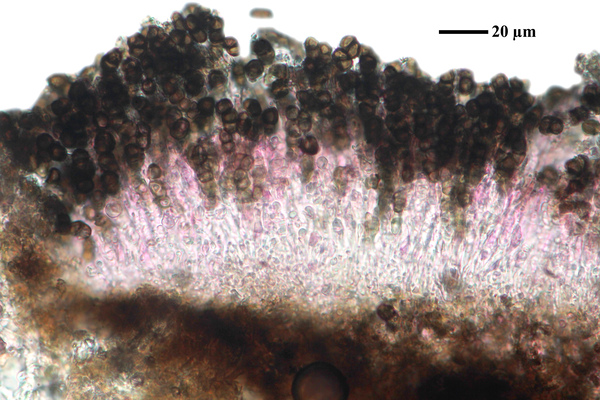

Felix Schumm - CC BY-SA 4.0
[TSB_16773], Spain, Castellò, Pina de Montalgrao, Santa Barbara, on quartzitic sandstone, c. 1300 m. Leg. V. Calatayud, 21.03.1992
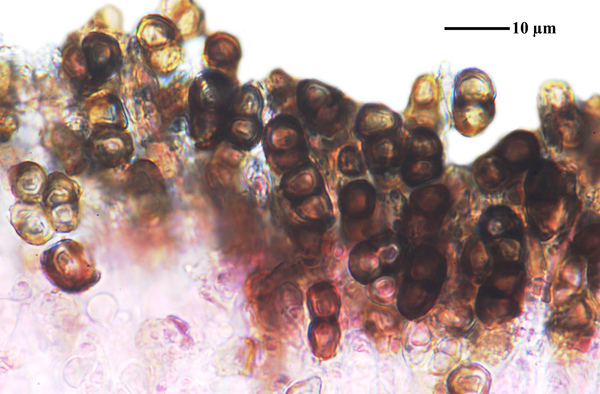

Felix Schumm - CC BY-SA 4.0
[TSB_16773], Spain, Castellò, Pina de Montalgrao, Santa Barbara, on quartzitic sandstone, c. 1300 m. Leg. V. Calatayud, 21.03.1992
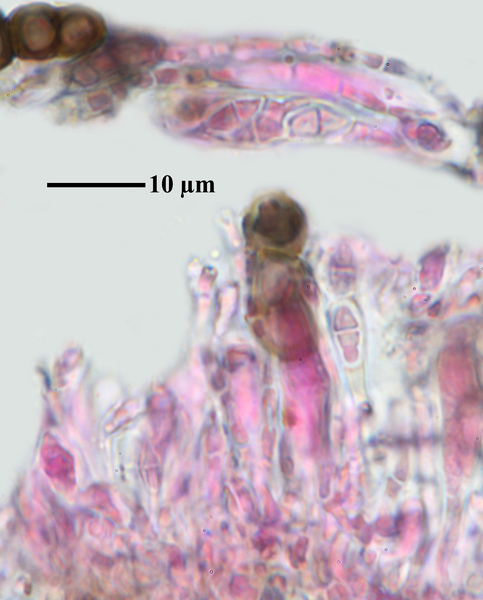

Felix Schumm - CC BY-SA 4.0
[TSB_16773], Spain, Castellò, Pina de Montalgrao, Santa Barbara, on quartzitic sandstone, c. 1300 m. Leg. V. Calatayud, 21.03.1992


Felix Schumm - CC BY-SA 4.0
[TSB_16773], Spain, Castellò, Pina de Montalgrao, Santa Barbara, on quartzitic sandstone, c. 1300 m. Leg. V. Calatayud, 21.03.1992
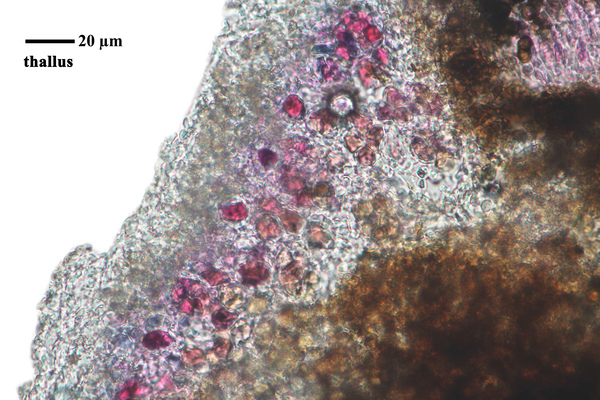

Felix Schumm - CC BY-SA 4.0
[TSB_16773], Spain, Castellò, Pina de Montalgrao, Santa Barbara, on quartzitic sandstone, c. 1300 m. Leg. V. Calatayud, 21.03.1992
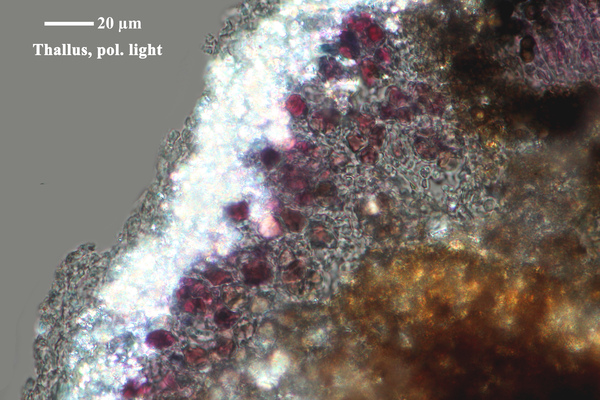

Felix Schumm - CC BY-SA 4.0
[TSB_16773], Spain, Castellò, Pina de Montalgrao, Santa Barbara, on quartzitic sandstone, c. 1300 m. Leg. V. Calatayud, 21.03.1992
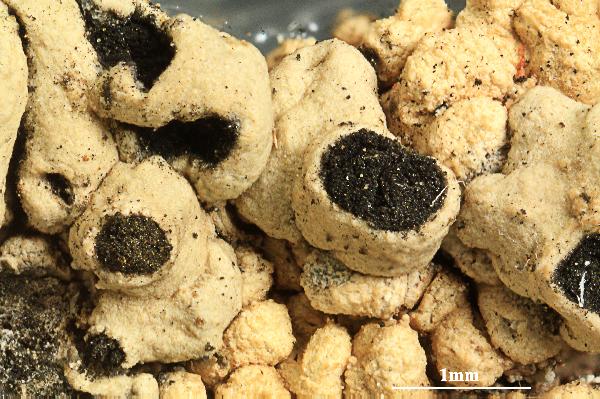

Felix Schumm - CC BY-SA 4.0
[VZR2162], Italia. Toscana, Prov. Arezzo, Radicofani, 760 m. Ad saxa
basaltica, in thallo Pertusariae sp. vigens. Leg. et det. M. Tretiach,
06.03.1997, conf. D. Puntillo. EX A. VEZDA: LICHENES RARIORES
EXSICCATI NR. 262.
Growth form: Crustose
Substrata: rocks
Photobiont: green algae other than Trentepohlia
Reproductive strategy: mainly sexual
Most common in areas with a humid-warm climate (e.g. most of Tyrrenian Italy)
paras Pertusaria spp.
Commonnes-rarity: (info)
Alpine belt: absent
Subalpine belt: absent
Oromediterranean belt: absent
Montane belt: very rare
Submediterranean belt: absent
Padanian area: absent
Humid submediterranean belt: very rare
Humid mediterranean belt: extremely rare
Dry mediterranean belt: absent

Predictive model
| Herbarium samples |


Felix Schumm - CC BY-SA 4.0
[TSB_16773], Spain, Castellò, Pina de Montalgrao, Santa Barbara, on quartzitic sandstone, c. 1300 m. Leg. V. Calatayud, 21.03.1992


Felix Schumm - CC BY-SA 4.0
[TSB_16773], Spain, Castellò, Pina de Montalgrao, Santa Barbara, on quartzitic sandstone, c. 1300 m. Leg. V. Calatayud, 21.03.1992


Felix Schumm - CC BY-SA 4.0
[TSB_16773], Spain, Castellò, Pina de Montalgrao, Santa Barbara, on quartzitic sandstone, c. 1300 m. Leg. V. Calatayud, 21.03.1992


Felix Schumm - CC BY-SA 4.0
[TSB_16773], Spain, Castellò, Pina de Montalgrao, Santa Barbara, on quartzitic sandstone, c. 1300 m. Leg. V. Calatayud, 21.03.1992


Felix Schumm - CC BY-SA 4.0
[TSB_16773], Spain, Castellò, Pina de Montalgrao, Santa Barbara, on quartzitic sandstone, c. 1300 m. Leg. V. Calatayud, 21.03.1992


Felix Schumm - CC BY-SA 4.0
[TSB_16773], Spain, Castellò, Pina de Montalgrao, Santa Barbara, on quartzitic sandstone, c. 1300 m. Leg. V. Calatayud, 21.03.1992


Felix Schumm - CC BY-SA 4.0
[TSB_16773], Spain, Castellò, Pina de Montalgrao, Santa Barbara, on quartzitic sandstone, c. 1300 m. Leg. V. Calatayud, 21.03.1992


 INDEX FUNGORUM
INDEX FUNGORUM
 GBIF
GBIF
